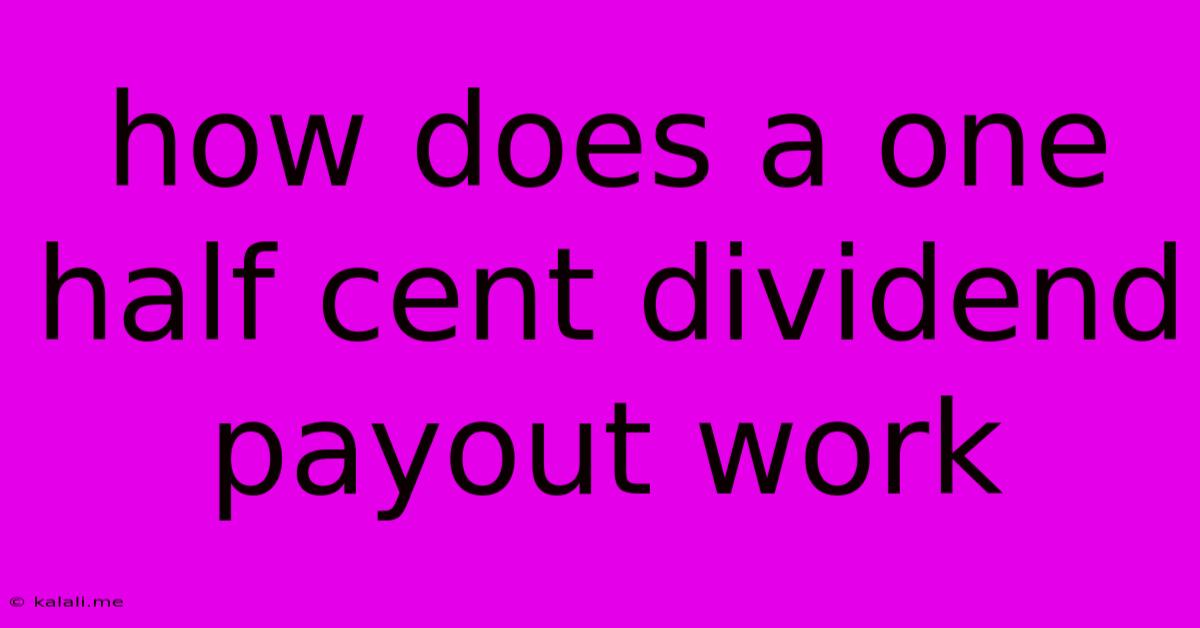How Does A One Half Cent Dividend Payout Work
Kalali
May 24, 2025 · 3 min read

Table of Contents
How Does a Half-Cent Dividend Payout Work?
A half-cent dividend, or a dividend payout of $0.005 per share, might seem unusual, but it's a perfectly legitimate practice. This article will break down exactly how these fractional dividend payments are handled, clarifying the mechanics and addressing common concerns. Understanding how these small payouts work is crucial for investors who want to maximize their returns and accurately track their investment portfolio performance.
Understanding Fractional Dividends: Many investors are accustomed to receiving dividends in whole cents, like $0.10 or $0.25 per share. However, companies sometimes declare dividends in fractions of a cent. This can happen for several reasons, including a company wanting to distribute a specific total dividend amount while maintaining a consistent dividend payout ratio relative to earnings or to avoid rounding up or down which could slightly alter the overall dividend budget. While seemingly insignificant, these fractions accumulate over time.
How Brokerages Handle Fractional Dividends: The key to understanding a half-cent dividend lies in how your brokerage handles it. Instead of receiving a physical half-cent, your brokerage will accumulate these fractional amounts. Here's what typically happens:
- Accumulation: Your brokerage will track the fractional dividend payments. They will add the small amounts to your account until they reach a certain threshold. This threshold varies depending on the brokerage firm.
- Cash Payment: Once the accumulated fractional dividends reach a specific value (e.g., $1 or more), your brokerage will typically issue a cash payment. This ensures that you're not losing out on small amounts.
- Reinvested Dividends (DRIP): If you're enrolled in a Dividend Reinvestment Plan (DRIP), your brokerage may use the accumulated fractional dividends to purchase additional shares of the company's stock. This effectively allows you to reinvest even the smallest dividend amounts, which can contribute to long-term growth through compounding.
Example:
Let's say you own 1,000 shares of a company that pays a $0.005 dividend. Your total dividend payment would be $5 (1,000 shares * $0.005/share). If you hold shares across multiple companies issuing fractional dividends, your brokerage will combine the fractional amounts from different sources to reach that payout threshold. This aggregated amount then gets deposited into your account.
Tax Implications: Despite the small size, fractional dividends are still taxable income. Your brokerage will typically issue you a tax statement (usually a 1099-DIV form in the US) at the end of the year, reporting all dividend income, including those fractional amounts.
Why Companies Pay Fractional Dividends:
- Precise Dividend Distribution: Paying a precise dividend, even if it's a fraction of a cent, allows companies to distribute their profits accurately and fairly among shareholders.
- Maintaining Consistency: Fractional dividends can help maintain a consistent dividend payout policy without needing to round up or down, which ensures the budget aligns with planned expenditures.
In Conclusion: A half-cent dividend may seem negligible at first glance, but understanding how brokerages handle these fractional amounts is crucial for accurate record-keeping and maximizing investment returns. Through accumulation and periodic cash payouts or DRIP reinvestment, investors can benefit from even the smallest dividend payments over time. Don't underestimate the power of compounding, even with these seemingly tiny fractions.
Latest Posts
Latest Posts
-
How To Keep Mice Out Of House
May 24, 2025
-
Condensation Point Temperature In Fahrenheit For Water
May 24, 2025
-
Difference Between Scotch Whiskey And Bourbon
May 24, 2025
-
How To Know If Sour Cream Is Bad
May 24, 2025
-
How Often Should You Change Your Furnace Filter
May 24, 2025
Related Post
Thank you for visiting our website which covers about How Does A One Half Cent Dividend Payout Work . We hope the information provided has been useful to you. Feel free to contact us if you have any questions or need further assistance. See you next time and don't miss to bookmark.